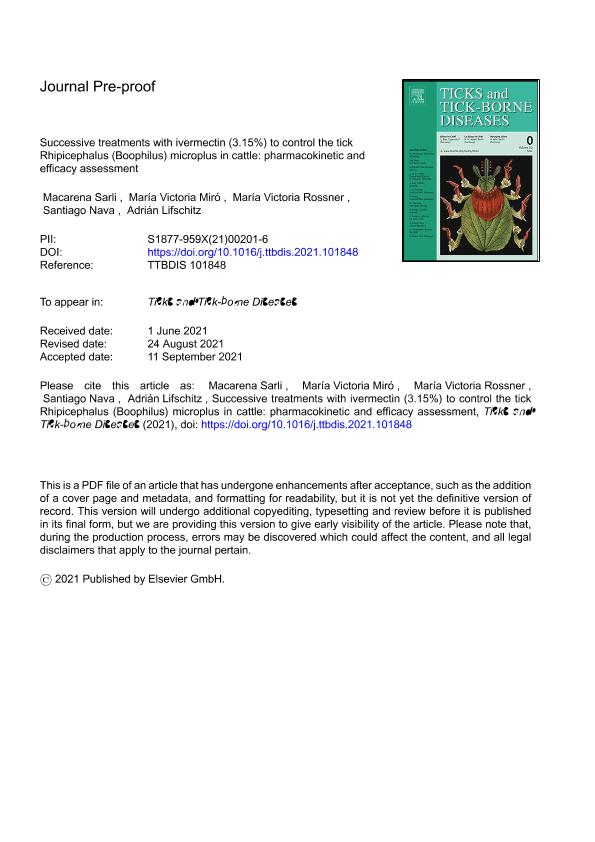Mostrar el registro sencillo del ítem
dc.contributor.author
Sarli, Macarena

dc.contributor.author
Miró, María Victoria

dc.contributor.author
Rossner, Maria Victoria

dc.contributor.author
Nava, Santiago

dc.contributor.author
Lifschitz, Adrian Luis

dc.date.available
2023-07-26T19:56:45Z
dc.date.issued
2022-01
dc.identifier.citation
Sarli, Macarena; Miró, María Victoria; Rossner, Maria Victoria; Nava, Santiago; Lifschitz, Adrian Luis; Successive treatments with ivermectin (3.15%) to control the tick Rhipicephalus (Boophilus) microplus in cattle: Pharmacokinetic and efficacy assessment; Elsevier; Ticks and Tick-borne Diseases; 13; 1; 1-2022; 1-6; 101848
dc.identifier.issn
1877-9603
dc.identifier.uri
http://hdl.handle.net/11336/205729
dc.description.abstract
This study aimed to evaluate the pharmacokinetics, the potential accumulation in the body of treated animals and the efficacy of ivermectin long-acting formulation (3.15%) against the cattle tick Rhipicephalus (Boophilus) microplus in a scheme of three successive treatments. Fifteen 12-month-old heifers, naturally infested with R. microplus, were divided into two groups (G). Cattle from GI (n = 10) were subjected to three treatments with ivermectin 3.15% (IVOMEC GOLD®, Merial Argentina S.A.) at a rate of 1 mL/50 kg on days 0, 35, and 70. Cattle from GII (n = 5) were not treated. From day 1 to 202 post-treatment blood samples were taken to measure ivermectin concentrations by HPLC and female ticks (4.5–8 mm) were counted to evaluate the efficacy of the treatment. The level of tick resistance to ivermectin was evaluated before and after finishing the scheme of successive treatments by larval immersion test (LIT) bioassay from engorged females collected from GI. The area under the concentration vs. time curves (AUC0–35d) obtained post-second treatment was 1.51 ± 0.39-fold higher than those observed post-first treatment (P<0.05). The mean plasma concentrations of ivermectin 3.15% at 20 days after the first, second and third treatment were 17.0, 27.5 and 37.8 ng/mL, respectively (P<0.01). The elimination half-life of ivermectin post-third treatment was significantly longer than that was previously reported after a single dose (P<0.01). Values of therapeutic efficacy percentage reached 75.6% post-first treatment and between 95.9 and 100% after the second treatment. Ticks evaluated by LIT showed a significant increase in lethal concentrations after treatments. Although the efficacy level was high, the successive treatments with long-acting ivermectin formulation generate a significant accumulation of drug in plasma and could increase the levels of resistance to this drug in the tick population.
dc.format
application/pdf
dc.language.iso
eng
dc.publisher
Elsevier

dc.rights
info:eu-repo/semantics/openAccess
dc.rights.uri
https://creativecommons.org/licenses/by-nc-nd/2.5/ar/
dc.subject
DRUG RESIDUES
dc.subject
IVERMECTIN 3.15%
dc.subject
PHARMACOKINETICS
dc.subject
RHIPICEPHALUS MICROPLUS
dc.subject
THERAPEUTIC EFFICACY
dc.subject.classification
Ciencias Veterinarias

dc.subject.classification
Ciencias Veterinarias

dc.subject.classification
CIENCIAS AGRÍCOLAS

dc.title
Successive treatments with ivermectin (3.15%) to control the tick Rhipicephalus (Boophilus) microplus in cattle: Pharmacokinetic and efficacy assessment
dc.type
info:eu-repo/semantics/article
dc.type
info:ar-repo/semantics/artículo
dc.type
info:eu-repo/semantics/publishedVersion
dc.date.updated
2023-06-28T15:08:26Z
dc.journal.volume
13
dc.journal.number
1
dc.journal.pagination
1-6; 101848
dc.journal.pais
Alemania

dc.description.fil
Fil: Sarli, Macarena. Consejo Nacional de Investigaciones Cientificas y Tecnicas. Centro Cientifico Tecnologico Conicet - Santa Fe. Instituto de Investigacion de la Cadena Lactea. - Instituto Nacional de Tecnologia Agropecuaria. Centro Regional Santa Fe. Estacion Experimental Agropecuaria Rafaela. Instituto de Investigacion de la Cadena Lactea.; Argentina
dc.description.fil
Fil: Miró, María Victoria. Consejo Nacional de Investigaciones Científicas y Técnicas. Centro Científico Tecnológico Conicet - Tandil. Centro de Investigación Veterinaria de Tandil. Universidad Nacional del Centro de la Provincia de Buenos Aires. Centro de Investigación Veterinaria de Tandil. Provincia de Buenos Aires. Gobernación. Comision de Investigaciones Científicas. Centro de Investigación Veterinaria de Tandil; Argentina
dc.description.fil
Fil: Rossner, Maria Victoria. Instituto Nacional de Tecnología Agropecuaria. Centro Regional Chaco-Formosa. Estación Experimental Agropecuaria Colonia Benítez; Argentina. Consejo Nacional de Investigaciones Científicas y Técnicas; Argentina
dc.description.fil
Fil: Nava, Santiago. Consejo Nacional de Investigaciones Cientificas y Tecnicas. Centro Cientifico Tecnologico Conicet - Santa Fe. Instituto de Investigacion de la Cadena Lactea. - Instituto Nacional de Tecnologia Agropecuaria. Centro Regional Santa Fe. Estacion Experimental Agropecuaria Rafaela. Instituto de Investigacion de la Cadena Lactea.; Argentina
dc.description.fil
Fil: Lifschitz, Adrian Luis. Consejo Nacional de Investigaciones Científicas y Técnicas. Centro Científico Tecnológico Conicet - Tandil. Centro de Investigación Veterinaria de Tandil. Universidad Nacional del Centro de la Provincia de Buenos Aires. Centro de Investigación Veterinaria de Tandil. Provincia de Buenos Aires. Gobernación. Comision de Investigaciones Científicas. Centro de Investigación Veterinaria de Tandil; Argentina
dc.journal.title
Ticks and Tick-borne Diseases
dc.relation.alternativeid
info:eu-repo/semantics/altIdentifier/doi/http://dx.doi.org/10.1016/j.ttbdis.2021.101848
dc.relation.alternativeid
info:eu-repo/semantics/altIdentifier/url/https://www.sciencedirect.com/science/article/pii/S1877959X21002016
Archivos asociados
